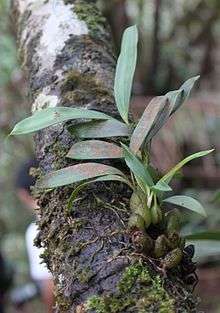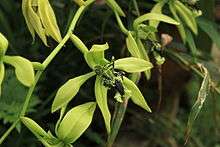Coelogyne
Coelogyne is a genus of over 200 sympodial epiphytes from the family Orchidaceae, distributed across India, China, Indonesia and the Fiji islands, with the main centers in Borneo, Sumatra and the Himalayas. They can be found from tropical lowland forests to montane rainforests. A few species grow as terrestrials or even as lithophytes in open, humid habitats. The genera Bolborchis Lindl., Hologyne Pfitzer and Ptychogyne Pfitzer are generally included here. The genus is abbreviated Coel. in trade journals.
| Coelogyne | |
|---|---|
 | |
| Coelogyne cristata | |
| Scientific classification | |
| Kingdom: | Plantae |
| Clade: | Tracheophytes |
| Clade: | Angiosperms |
| Clade: | Monocots |
| Order: | Asparagales |
| Family: | Orchidaceae |
| Subfamily: | Epidendroideae |
| Tribe: | Arethuseae |
| Subtribe: | Coelogyninae |
| Genus: | Coelogyne Lindl. 1821 |
| Species | |
|
See text. | |
| Wikimedia Commons has media related to Coelogyne. |
| Wikispecies has information related to Coelogyne |
Name
The name Coelogyne was first published as Caelogyne in 1921 by John Lindley.[1] and is derived from the Ancient Greek words κοῖλος (koîlos, hollow) and γῠνή (gunḗ, woman), referring to the concave stigma.
A few species are commonly known as "necklace orchids", because of their long, pendant, multi-flowered inflorescence.
Description
This genus lacks the saccate base of the labellum, a typical characteristic which is present in the other genera in the subtribe Coelogyninae. The free lip has high lateral lobes along the basal part of the labellum (hypochile) and smooth, toothed or warty keels.
The pseudobulbs of one internode vary in size. They may be closely or widely spaced through sympodial growth along the rhizome.
Inflorescences often show a small to very large number of showy, medium-sized to large flowers. They may arise either from the apex of the newly completed pseudobulb at the end of the growing season (as in Coelogyne fimbriata), or may precede the new growth in early spring (as in Coelogyne cristata). The typical colour range of this genus is white, through tawny brown to green, and occasionally peachy tones. All species have four pollinia.
They have often a sweet scent, attracting different kinds of pollinators, such as bees, wasps and beetles.
Distribution
The cooler growing species such as Coelogyne fimbriata, Coelogyne ovalis, Colegyne fuliginosa, Coelogyne cristata, Coelogyne flaccida, Coelogyne nitida originate in the Himalayan region of India and southeast Asia.
Taxonomy
The traditional taxonomy of the genus Coelogyne is still disputed. Coelogyne has been subdivided in 23 sections or subgenera by De Vogel (1994) and Clayton. Molecular data show that Coelogyne is paraphyletic and should be reorganised. It should include the genera Neogyna and Pholidota, and several sections should be removed, including Cyathogyne, Tomentosae, Rigidiformes, Veitchiae and Verrucosae. This new genus Coelogyne should then contain about 160 species.[2]
The type species is Coelogyne cristata.
Species

_Schltr.%2C_Repert._Spec._Nov._Regni_Veg._10-_17_(1911)_(33685235420).jpg)
The database IPNI gives 415 entries for this genus, but a large number are invalid or have become synonyms. These are not mentioned in the following traditional list.
- Coelogyne acutilabium de Vogel
- Coelogyne albobrunnea J.J.Sm.
- Coelogyne albolutea Rolfe
- Coelogyne anceps Hook.f.
- Coelogyne asperata Lindl.
- Coelogyne assamica Linden & Rchb.f.
- Coelogyne barbata Lindl. ex Griff.
- Coelogyne beccarii Rchb.f.
- Coelogyne bicamerata J.J.Sm.
- Coelogyne bilamellata Lindl.
- Coelogyne borneensis Rolfe
- Coelogyne brachygyne J.J.Sm.
- Coelogyne brachyptera Rchb.f.
- Coelogyne breviscapa Lindl.
- Coelogyne bruneiensis de Vogel
- Coelogyne buennemeyeri J.J.Sm.
- Coelogyne calcarata J.J.Sm.
- Coelogyne calcicola Kerr
- Coelogyne caloglossa Schltr.
- Coelogyne candoonensis Ames
- Coelogyne carinata Rolfe.
- Coelogyne celebensis J.J.Sm.
- Coelogyne chanii Gravend. & de Vogel
- Coelogyne chlorophaea Schltr.
- Coelogyne chloroptera Rchb.f.
- Coelogyne clemensii Ames & C.Schweinf. in O.Ames.
- Coelogyne clemensii var. angustifolia Carr
- Coelogyne clemensii var. clemensii
- Coelogyne clemensii var. longiscapa Ames & C.Schweinf. in O.Ames
- Coelogyne compressicaulis Ames & C.Schweinf. in O.Ames
- Coelogyne concinna Ridl.
- Coelogyne confusa Ames.
- Coelogyne contractipetala J.J.Sm.
- Coelogyne corymbosa Lindl.
- Coelogyne crassiloba J.J.Sm.
- Coelogyne craticulilabris Carr
- Coelogyne cristata Lindl.
- Coelogyne cumingii Lindl.
- Coelogyne cuprea H.Wendl. & Kraenzl.
- Coelogyne cuprea var. cuprea
- Coelogyne cuprea var. planiscapa J.J.Wood & C.L.Chan
- Coelogyne dichroantha Gagnep
- Coelogyne distans J.J.Sm.
- Coelogyne dulitensis Carr.
- Coelogyne eberhardtii Gagnep
- Coelogyne ecarinata C.Schweinf.
- Coelogyne echinolabium de Vogel
- Coelogyne elmeri Ames.
- Coelogyne endertii J.J.Sm.
- Coelogyne exalata Ridl.
- Coelogyne filipeda Gagnep.
- Coelogyne fimbriata Lindl.
- Coelogyne flaccida Lindl.
- Coelogyne flexuosa Rolfe.
- Coelogyne foerstermannii Rchb.f..
- Coelogyne formosa Schltr.
- Coelogyne fragrans Schltr.
- Coelogyne fuerstenbergiana Schltr.
- Coelogyne fuscescens Lindl.
- Coelogyne fuscescens var. brunnea (Lindl.) Lindl..
- Coelogyne fuscescens var. fuscescens
- Coelogyne fuscescens var. integrilabia Pfitzer in H.G.A.Engler (ed.).
- Coelogyne genuflexa Ames & C.Schweinf. in O.Ames.
- Coelogyne ghatakii T.K.Paul, S.K.Basu & M.C.Biswas
- Coelogyne gibbifera J.J.Sm.
- Coelogyne glandulosa Lindl.
- Coelogyne glandulosa var. bournei S.Das & S.K.Jain
- Coelogyne glandulosa var. glandulosa
- Coelogyne glandulosa var. sathyanarayanae S.Das & S.K.Jain
- Coelogyne gongshanensis H.Li ex S.C.Chen.
- Coelogyne griffithii Hook.f.
- Coelogyne guamensis Ames
- Coelogyne hajrae Phukan.
- Coelogyne harana J.J.Sm.
- Coelogyne hirtella J.J.Sm.
- Coelogyne hitendrae S.Das & S.K.Jain.
- Coelogyne holochila P.F.Hunt & Summerh.
- Coelogyne huettneriana Rchb.f.
- Coelogyne imbricans J.J.Sm.
- Coelogyne incrassata (Blume) Lindl.
- Coelogyne incrassata var. incrassata
- Coelogyne incrassata var. sumatrana J.J.Sm.
- Coelogyne incrassata var. valida J.J.Sm.
- Coelogyne integerrima Ames
- Coelogyne integra Schltr.
- Coelogyne judithiae P.Taylor
- Coelogyne kaliana P.J.Cribb.
- Coelogyne kelamensis J.J.Sm.
- Coelogyne kemiriensis J.J.Sm..
- Coelogyne kinabaluensis Ames & C.Schweinf. in O.Ames.
- Coelogyne lacinulosa J.J.Sm.
- Coelogyne latiloba Vogel
- Coelogyne lawrenceana Rolfe
- Coelogyne lentiginosa Lindl.
- Coelogyne leucantha W.W.Sm.
- Coelogyne lockii Aver.
- Coelogyne loheri Rolfe
- Coelogyne longiana Aver.
- Coelogyne longibulbosa Ames & C.Schweinf. in O.Ames.
- Coelogyne longifolia (Blume) Lindl.
- Coelogyne longipes Lindl.
- Coelogyne longirachis Ames
- Coelogyne longpasiaensis J.J.Wood & C.L.Chan
- Coelogyne lycastoides F.Muell. & Kraenzl.
- Coelogyne macdonaldii F.Muell. & Kraenzl.
- Coelogyne malintangensis J.J.Sm..
- Coelogyne malipoensis Z.H.Tsi
- Coelogyne marmorata Rchb.f.
- Coelogyne marthae S.E.C.Sierra
- Coelogyne mayeriana Rchb.f.
- Coelogyne merrillii Ames
- Coelogyne micrantha Lindl.
- Coelogyne miniata (Blume) Lindl.
- Coelogyne monilirachis Carr
- Coelogyne monticola J.J.Sm.
- Coelogyne mooreana Rolfe
- Coelogyne mossiae Rolfe
- Coelogyne motleyi Rolfe ex J.J.Wood, D.A.Clayton & C.L.Chan
- Coelogyne moultonii J.J.Sm.
- Coelogyne multiflora Schltr.
- Coelogyne muluensis J.J.Wood
- Coelogyne naja J.J.Sm.
- Coelogyne nervosa A.Rich.
- Coelogyne nitida (Wall. ex D.Don) Lindl.
- Coelogyne obtusifolia Carr
- Coelogyne occultata Hook.f.
- Coelogyne occultata var. occultata
- Coelogyne occultata var. uniflora N.P.Balakr.
- Coelogyne odoardoi Schltr.
- Coelogyne odoratissima Lindl.
- Coelogyne ovalis Lindl.
- Coelogyne palawanensis Ames
- Coelogyne pandurata Lindl. : Black Orchid
- Coelogyne papillosa Ridl. ex Stapf.
- Coelogyne parishii Hook.f.
- Coelogyne peltastes Rchb.f.
- Coelogyne pempahisheyana H.J.Chowdhery
- Coelogyne pendula Summerh. ex Perry
- Coelogyne pholidotoides J.J.Sm.
- Coelogyne picta Schltr.
- Coelogyne planiscapa Carr.
- Coelogyne planiscapa var. grandis Carr.
- Coelogyne planiscapa var. planiscapa
- Coelogyne plicatissima Ames & C.Schweinf. in O.Ames
- Coelogyne prasina Ridl.
- Coelogyne prolifera Lindl.
- Coelogyne pulchella Rolfe.
- Coelogyne pulverula Teijsm. & Binn.
- Coelogyne punctulata Lindl.
- Coelogyne punctulata f. brevifolia (Lindl.) S.Das & S.K.Jain
- Coelogyne punctulata f. punctulata
- Coelogyne quadratiloba Gagnep.
- Coelogyne quinquelamellata Ames
- Coelogyne radicosa Ridl.
- Coelogyne radioferens Ames & C.Schweinf. in O.Ames
- Coelogyne raizadae S.K.Jain & S.Das.
- Coelogyne remediosae Ames & Quisumb.
- Coelogyne renae Gravend. & de Vogel.
- Coelogyne rhabdobulbon Schltr.
- Coelogyne rigida C.S.P.Parish & Rchb.f.
- Coelogyne rigidiformis Ames & C.Schweinf.
- Coelogyne rochussenii de Vriese
- Coelogyne rumphii Lindl.
- Coelogyne rupicola Carr.
- Coelogyne salmonicolor Rchb.f.
- Coelogyne sanderae Kraenzl. ex O'Brien
- Coelogyne sanderiana Rchb.f.
- Coelogyne schilleriana Rchb.f. & K.Koch.
- Coelogyne schultesii S.K.Jain & S.Das.
- Coelogyne septemcostata J.J.Sm.
- Coelogyne sparsa Rchb.f.
- Coelogyne speciosa (Blume) Lindl.
- Coelogyne speciosa subsp. fimbriata (J.J.Sm.) Gravend.
- Coelogyne speciosa subsp. incarnata Gravend.
- Coelogyne speciosa subsp. speciosa
- Coelogyne squamulosa J.J.Sm.
- Coelogyne steenisii J.J.Sm.
- Coelogyne stenobulbum Schltr.
- Coelogyne stenochila Hook.f.
- Coelogyne stricta (D.Don) Schltr.
- Coelogyne suaveolens (Lindl.) Hook.f.
- Coelogyne susanae P.J.Cribb & B.A.Lewis
- Coelogyne swaniana Rolfe
- Coelogyne tenasserimensis Seidenf.
- Coelogyne tenompokensis Carr.
- Coelogyne tenuis Rolfe
- Coelogyne testacea Lindl.
- Coelogyne tiomanensis M.R.Hend.
- Coelogyne tomentosa Lindl. : Necklace Orchid
- Coelogyne tommii Gravend. & P.O'Byrne
- Coelogyne trilobulata J.J.Sm.
- Coelogyne trinervis Lindl.
- Coelogyne triplicatula Rchb.f.
- Coelogyne triuncialis P.O'Byrne & J.J.Verm.
- Coelogyne tumida J.J.Sm.
- Coelogyne undatialata J.J.Sm.
- Coelogyne usitana Roeth & O.Gruss.
- Coelogyne ustulata C.S.P.Parish & Rchb.f.
- Coelogyne vanoverberghii Ames
- Coelogyne veitchii Rolfe
- Coelogyne velutina de Vogel
- Coelogyne venusta Rolfe
- Coelogyne vermicularis J.J.Sm.
- Coelogyne verrucosa S.E.C.Sierra
- Coelogyne virescens Rolfe
- Coelogyne viscosa Rchb.f.
- Coelogyne weixiensis X.H.Jin (2005)
- Coelogyne xyrekes Ridl.
- Coelogyne yiii Schuit. & de Vogel
- Coelogyne zhenkangensis S.C.Chen & K.Y.Lang
- Coelogyne zurowetzii Carr
Hybrids
Coelogyne hybrids include:
- Coelogyne Memoria W. Micholitz (C. mooreana × C. lawrenceana)
- Coelogyne Linda Buckley (C. mooreana × C. cristata)
- Coelogyne Burfordiense (C. pandurata × C. asperata).
- Coelogyne South Carolina (C. pandurata × C. burfordiense), sometimes called "the black orchid" because of the black coloration of the heavily patterned and structured lip.
Cultivation
The wide distribution of this genus has resulted in a wide variety of temperature requirements from species to species, some requiring cool to cold conditions to grow and bloom reliably, while others need decidedly warmer temperatures to achieve the same.
The orchids in this genus require a decided rest period during winter in which they receive no feed, very little water (enough to prevent pseudobulbs shrivelling), cool to cold temperatures and high light. These conditions seem to aid flowering in spring for some growers, though others report that more constant conditions can also produce regular flowering.
Notes
- Lindley, J. 1821. Collectanea Botanica, ad pl. 33 and pl. 37
- Gravendeel, B. (2000). Reorganising the orchid genus Coelogyne: A phylogenetic classification based on morphology and molecules. Nationaal Herbarium Nederland.
References
- Teuscher, H. 1976. Coelogyne and Pleione. American Orchid Society Bulletin 45(8):688.
